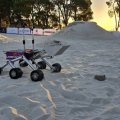Queensland Fire and Emergency Services (QFES), The University of Queensland and the Bureau of Meteorology (BoM) are undertaking an Australian-first research project to study bushfires in an effort to better protect lives and property.
UQ Geographical Sciences Honours student Nicholas McCarthy will lead a pilot project to understand and model the intense columns of heat above bushfires, known as convective plumes.
He will join firefighters in tracking bushfires this summer, using UQ’s new mobile Doppler weather radar, unmanned aerial vehicles, weather balloons and the Bureau of Meteorology's fixed radar network in research set to improve bushfire forecasting and management.
“We are working collaboratively with QFES fire behaviour analysts and the Bureau of Meteorology’s fire weather forecasters to direct our research towards the big questions around fire and atmosphere interactions in catastrophic wildfires,” Mr McCarthy said.
“QFES will provide fire behaviour analysis from the ground and will assist us get close enough to the fires to make our observations, while ensuring that everyone stays safe.
“The convective plume above a bushfire contributes to the spread of a fire through spotting, especially in an intense wildfire scenario such as the Black Saturday fires.
“This project will begin to answer critical questions about the interaction of these plumes with the surrounding atmosphere and the impact this has on fire behaviour.”
Researchers will track bushfires around south-east Queensland in coming months to observe wind and temperature structure above them.
QFES Fire Behaviour Analyst Andrew Sturgess said the fire service was pleased to be involved with the internationally-important fire weather and behaviour research project.
“We all understand that hot, windy and dry weather can cause heightened and dangerous fire weather conditions,” Mr Sturgess said.
“What we don’t have, is solid research about how atmospheric coupling and pyro-convection over bushfires affects fire behaviour on the ground.
“This new research will help verify our existing fire behaviour models and theories and will greatly enhance fire behaviour analyst’s understanding about the upper atmosphere affects bushfire behaviour in Queensland, Australia and around the world.
“We look forward to using the results of this research pr actically, to keep Queensland communities safe from the threat of fire and hope to continue this great partnership with UQ and BoM in future research projects.”
actically, to keep Queensland communities safe from the threat of fire and hope to continue this great partnership with UQ and BoM in future research projects.”
BoM senior fire weather forecaster and recipient of the national Emergency Service medal for her role in forecasting Black Saturday, Claire Yeo, has years of experience in extreme wildfire scenarios.
“The partnership between QFES, UQ and the Bureau of Meteorology is an important collaboration for linking university research to emergency operations,” she said.
“This research will contribute to aiding fire behaviour analysts and fire managers to better understand fire behaviour, with the end goal of further reducing risk to communities in bushfire prone areas."
Media: UQ Geographical Sciences Honours student Nicholas McCarthy, 0457 475 503, nicholas.mccarthy@uqconnect.edu.au; Faculty of Science Engagement Officer Aimee Parker, 3346 1629, a.parker3@uq.edu.au; BOM Senior Severe Weather Meteorologist Claire Yeo, 03 9669 4065, c.yeo@bom.gov.au; QFES Media, 07 3635 3310, media@qfes.qld.gov.au.











